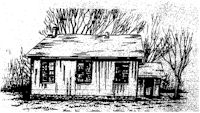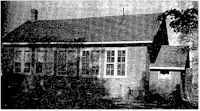| The following
is an abbreviated and edited transcription of a booklet prepared by 1992
Egypt School Homecoming Picnic organizers, who are listed at the end of
this article. The original source document, which was based on surviving
school log books, is on file in the archives of the Teeterville Pioneer
Museum in Teeterville, Norfolk County.
History of Egypt School, 1867-1959
Egypt School (Section School 9, Windham Township) was a frame building
erected on Lot 16, Concession 9 South, Windham Township. It was covered
with grey brick and an annex was added in the 1950s.
In 1865, the log school house at Brandy Creek , became too old for further use. As the school section then extended from LaSalette to Woodpecker’s Point (Lynnville), the section was divided at Brandy Creek, and the McKnight and Egypt Schools were founded.
The first school taught in our section was held in the home of Jacob Sensebaugh, who lived across the road, about 100 yards north of the present school. Three families hired Miss Katherine Chevelier, who possessed a fair education but held no teaching certificate.
The next year, John Shaver, Timothy Chevalier and Jacob Sensebaugh were elected trustees. These men cleared the present school site off John Shaver’s farm and the people in the section formed a bee to build the first school. Lumber was purchased from James Hinks’ sawmill at Rattlesnake Harbour (Ellaton), and this was hauled to the school via the Grand Trunk right-of-way which was used as the main road for several years before the railway was brought through.
This section has always been known for the cultivation of corn, and it has been suggested that the name Egypt became associated with this section from the Biblical reference to Joseph’s brothers who were forced to go into Egypt to buy corn.
Mrs. Duff, a resident of the Shaver farm, was an outstanding worker and took a great interest in all community affairs. She became known as the “Egyptian Queen,” and played a prominent part in promoting the building of the new school. Under these circumstances, it is quite evident why the name Egypt was selected as the appellation of this school.
Egypt School opened in 1867, with Miss Nellie Tait as teacher. The school became a community centre where school, church and public meetings were held.
By 1885, the school was judged inadequate, and the present school was built just north of the original, by Robert Wood. (The old school was moved to Will Stetler’s farm to be used as a drive-house and this old structure is still in use as a farm building.)
Since that time, many improvements in both the organization and school building have been
made...
The six-week vacation was extended to include the two summer months. The winter classes of young men and women gradually lost favour and as the next generation came on they received the same training at a much younger age.
The school library was started about 1900 and now included over 300 volumes. A flag-pole was erected in 1908 and the following year cloak-rooms were built for both boys and girls. The maps now in use were purchased – three in 1909, three in 1911 and two in 1919.
The water supply was improved by the installation of a new pump in 1922. The majority of the present desks were installed in 1922, but the newer ones were put in 10 years later.
During the summer of 1926, new hardwood floors were laid. Two years later the front blackboards were put in to replace the hylo-plate which were later moved to the north side.
The windows in the north side were boarded over in 1930, to afford better lighting conditions. The same year, the school was painted its present colour.
In 1934, a new fence was erected and the school was re-shingled on the south side.
George Boughner, secretary-treasurer, was first elected trustee in 1909. Walter Glynn, the chairman of the board, was elected trustee in 1917, The third trustee, Jim McMahon, has served this section since 1925.
In 1935, the general appearance of the school house was enhanced by three stone-enclosed flower beds in which annuals, perennials and shrubs were planted as an agricultural project of the pupils. Four yards of gravel were placed at the north and south entrances.
In 1936, a water-fountain was placed in the school to enable the pupils to get a drink without leaving the classroom. Sanitary conditions were improved by introducing the use of paper towels. Seven new pupil desks were installed to relieve over-crowded conditions. The teacher’s equipment was improved by the purchase of three new maps, North America, South America and Europe.
At the Annual Meeting held on 30 Dec 1950, Isaac Odenback succeeded George Boughner as trustee and secretary-treasurer. George Boughner served this section faithfully as a member of the Board of Trustees for 19 years.
It would appear that the use of “Log” books such as the one from which the foregoing account was taken, was discontinued (probably in 1941-42) as no further copies were found among the records from Egypt School. The Registers from that date until the closing of the School in 1959, provide a few interesting facts and notations…
The 30 Dec 1930 Annual Report lists the teacher’s annual salary as $900.
Arbor Day, early in May, was always a joy. Raking and burning leaves, picking up rubbish and making the school ground look neat and tidy … always followed by a time of games and goodies.
S. S. 9 (Egypt) Teachers included:
Mary Moore – 1865
Katherine Chevelier – 1865
Nellie Tait – 1867
George Schiltz – 1867
Flossie Rush (Slaght) – 1914
Zita M. Pettit (Clark) – 1918
Laurine Boll – 1919-1933
S. S. 9 (Egypt) Trustees included:
John Shaver, Tomothy Chevelier, Jacob Sensebaugh – 1865
George Boughner – 1909-1936
Walter Glynn – 1917-1936
Jim Mahon – 1925-
County Public School Inspector:
H. Frank Cook – 1918-1931
| The 1992 Homecoming Picnic Committee |
Gilda Cunningham
Gabriel DeVos
Florence Francke
Dorothy Glynn
Harry Glynn
Walter Glynn
Celcilla Hayens
John McMahon
Mike McMahon
|
Susan Platteouw, Chairman
Bell Pond
Harold Pond
Pearl Ratch, Sec.-Treasuerer
Lloyd Vanderburg
Shirley Webster
Lawrence Wiwchalryk
Beatrice Wray
Harry Wray
|
|
|


Egypt School, circa 1950s
|

